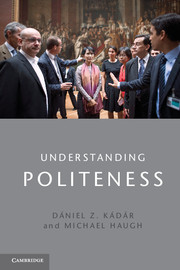Book contents
- Frontmatter
- Contents
- List of figures
- List of tables
- Foreword
- Acknowledgements
- 1 Introduction
- Part I Theoretical framework
- Part II Politeness and time
- 6 Politeness in interaction
- 7 Politeness, convention and rituality
- 8 Politeness and history
- Part III Politeness and social space: from mind to society
- Notes
- Glossary
- References
- Index
6 - Politeness in interaction
Published online by Cambridge University Press: 05 June 2014
- Frontmatter
- Contents
- List of figures
- List of tables
- Foreword
- Acknowledgements
- 1 Introduction
- Part I Theoretical framework
- Part II Politeness and time
- 6 Politeness in interaction
- 7 Politeness, convention and rituality
- 8 Politeness and history
- Part III Politeness and social space: from mind to society
- Notes
- Glossary
- References
- Index
Summary
Introduction
It has long been recognised that time is fundamentally constitutive of social action in interaction. In the course of reconceptualising politeness as social practice in Chapters 4 and 5, we have argued that time both constrains and affords understandings of politeness in various ways. For this reason, it is important to analyse understandings of politeness as they arise in situated interactions. However, to situate politeness in interaction need not necessitate a narrow focus on micro-analyses of individual encounters. We have suggested that particular understandings of politeness in the here-and-now are inevitably interlinked with understandings of politeness in the there-and-then, both over the course of the relational histories of those participants, and across the multitude of interactions through which the relational network(s) and attendant moral order(s) that are involved are constituted. In other words, we assume here a view of interaction as a meeting point between time in the sense of the locally situated here-and-now, and time in the sense of the historically and socially relative there-and-then.
To illustrate what we mean by this, consider example (1), from the American film Trains, Planes and Automobiles. The interaction begins after Neal has been forced to walk a considerably long way back from the carpark having found his rental car was not there, adding to his numerous trials in trying to get back home for Thanksgiving after his flight was cancelled.
- Type
- Chapter
- Information
- Understanding Politeness , pp. 109 - 136Publisher: Cambridge University PressPrint publication year: 2013



